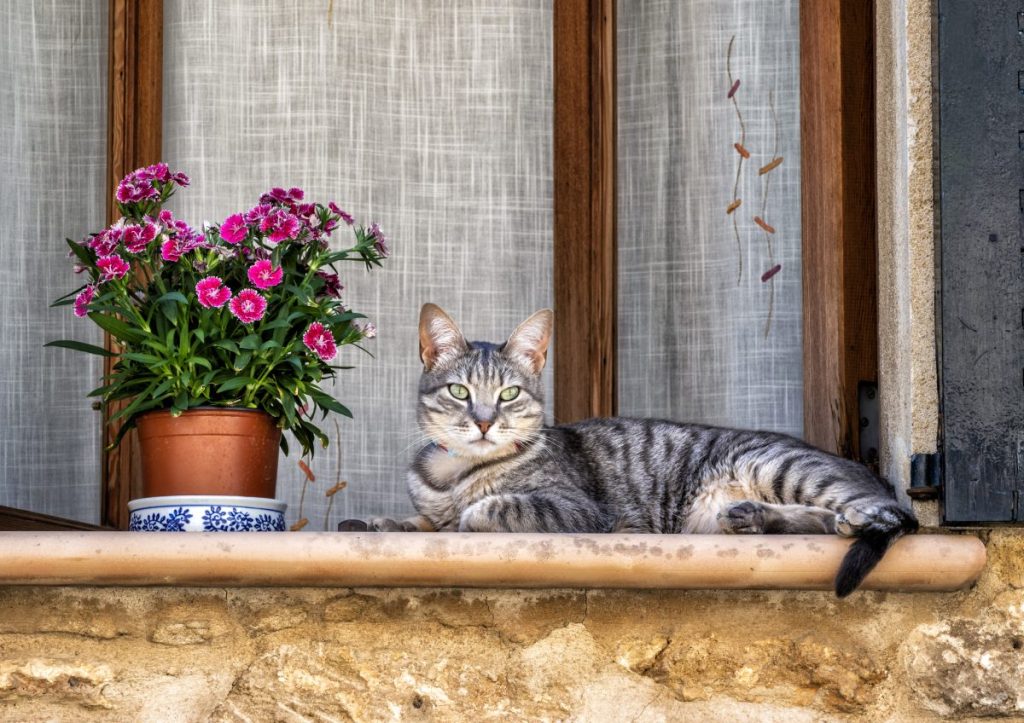Many cats love the great outdoors. But pet professionals agree that an indoor life is far healthier for them. That way, they’re safe from outdoor hazards. Also, their people tend to pay closer attention to them and notice signs of health problems earlier.
The upshot of being an indoor cat? A much longer life span. An all-indoor cat lives an average of 13 to 17 years, whereas a cat who’s allowed to roam is likely to survive just two to five years. That said, they may live longer depending on a few factors, like where they live.
The one absolute rule when making the indoor-outdoor decision: declawed kitties should be kept inside. We don’t recommend that you ever declaw a cat, but sometimes people adopt cats who are already declawed. Declawed cats can’t defend themselves from dogs, other cats, or predators, making the outdoors even riskier.
But if your kitty’s got their claws, and you’re still on the fence about whether to let them outdoors, here are a few things to consider.
Pros and cons of keeping cats indoors
Indoor cats have quite a few things going for them that contribute to their longer average lifespans. Outdoor cats face a lot of day-to-day dangers that indoor cats don’t.
Indoor cats won’t:
- Get hit by a car
- Get lost
- Be attacked by dogs, other cats, and predators
- Eat poison left out by unthinking or malicious neighbors
- Pick up parasites like fleas and ticks unless they’re brought inside by another person or pet
- Catch diseases spread by other cats
There are, however, some cons for cats who live indoors all the time, too. You can take steps to avoid these drawbacks, even if your cat stays inside.
The drawbacks might not outweigh the benefits of keeping your cat indoors, but they’re still important things to consider.
Indoor cats might:
- Get bored and engage in unwanted behavior
- Grow lethargic and gain weight more easily
- Vocalize loudly when you leave, especially if they have separation anxiety
Pros and cons of letting cats outdoors
While it may be risky to let your cat outside, outdoor cats do get some benefits from being able to experience life in nature. They have shorter average lifespans, of course, but maybe you find that consequence to be worth it for your cat to be able to roam as they please.
Cats outside enjoy:
- More exercise
- More stimulation from the outside world
- The pleasure of fresh air and sunshine
With those benefits in mind, it’s also important to understand the drawbacks of letting your cat roam outdoors. Cats who roam outside face far more dangers than indoor cats, and they often die much earlier — often in painful ways.
Outdoor cats might:
- Get hit by cars
- Get lost
- Face attacks from dogs, other cats, or predators
- Eat poison left out by unthinking or malicious neighbors
- Pick up parasites like fleas and ticks
- Suffer from diseases spread by other cats
Keeping cats safe while outdoors
If you want your cat to get the benefits of going outside without facing the risks of true outdoor cats, your best bet is to build an enclosure in your yard. That way, your cat can watch birds and squirrels and do some climbing, yet be safe from many of the dangers they’d face outside of the enclosure.
Consider “catio” enclosures. They’re screened-in areas for cats, and some will connect to a window or cat door so your kitty can come and go from the house as they please. Outdoor playpens for cats can present another option.
If you want to let your cat enjoy the whole yard, you can install special fencing to keep them safely enclosed. These solutions aren’t always perfect for keeping wildlife out of your yard, but they might work for your particular area and living situation.
You can also train some cats to walk on a leash. This will let you spend time outside with your cat while keeping them safe and under control.
If you let your cat roam outside, microchip them for identification and outfit them with a reflective, breakaway collar and current identification tags.
Keeping your indoor cat entertained
Many people who chose to let their cats outside believe that indoor cats will be bored, overweight, and unfulfilled. You can prevent all of these downsides if you’re a responsible, thoughtful cat parent.
To liven up an indoor cat’s environment, give them access to at least two of the following:
- A floor-to-ceiling cat tree for their climbing pleasure
- At least one window-side perch that gives them a view of a bird feeder or other outdoor wildlife
- An aquarium that they can enjoy watching but not fall into
- Interactive toys that require them to use their brain and their physical skills to acquire treats
- Daily playtime, petting, and training
- A tall, heavy-duty scratching post that allows them to stretch, sharpen their claws, and leave their signature scent from the glands in their paws
- A cat wheel or other interactive exercise toy that will get them moving
Safe ways for cats to explore
Indoor cats live longer, healthier lives, but if you want to let your kitty outside, there are safer ways to do it.
A cat enclosure gives you the best of both worlds. It allows your cat to get out in nature without facing the dangers of roaming where they please.
We do not recommend letting your cat roam outdoors. The risks are too high, and if you’re a diligent cat parent, you can still provide an indoor cat with all of the benefits that outdoor cats get.









